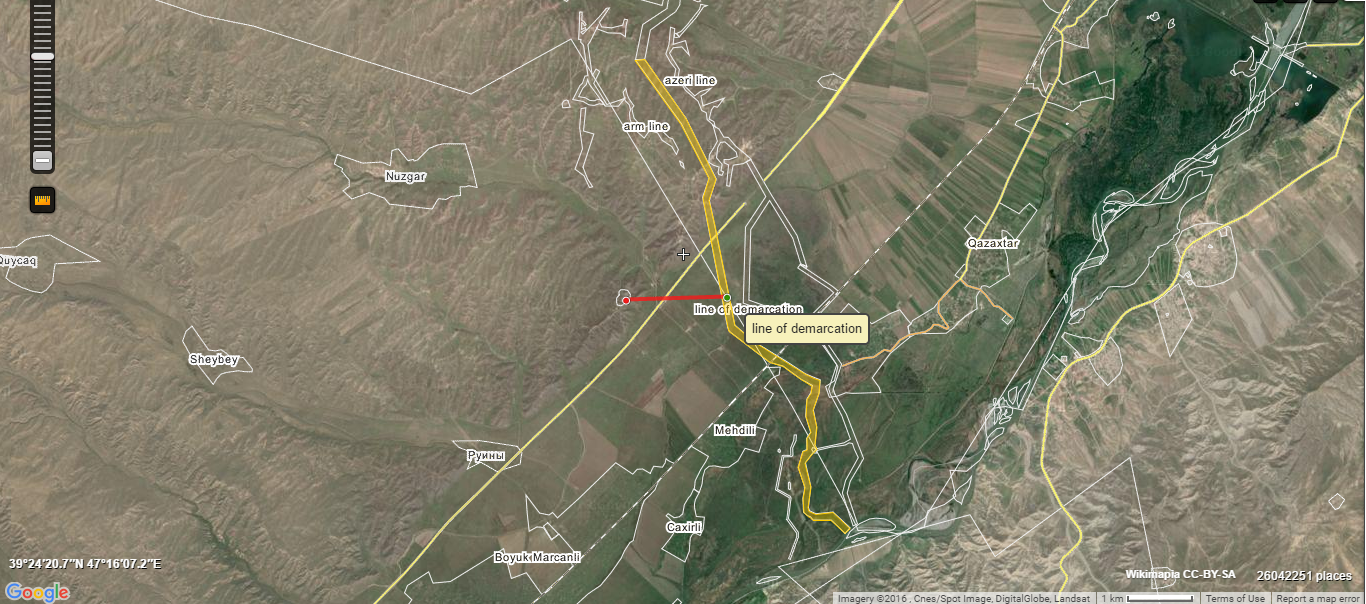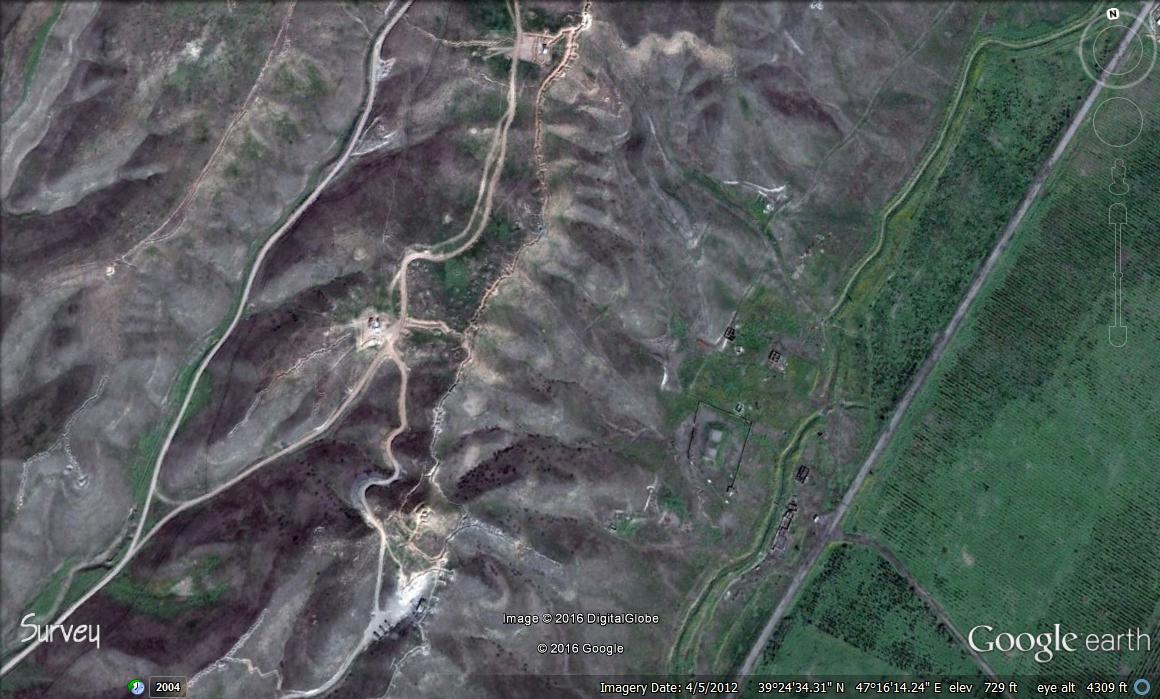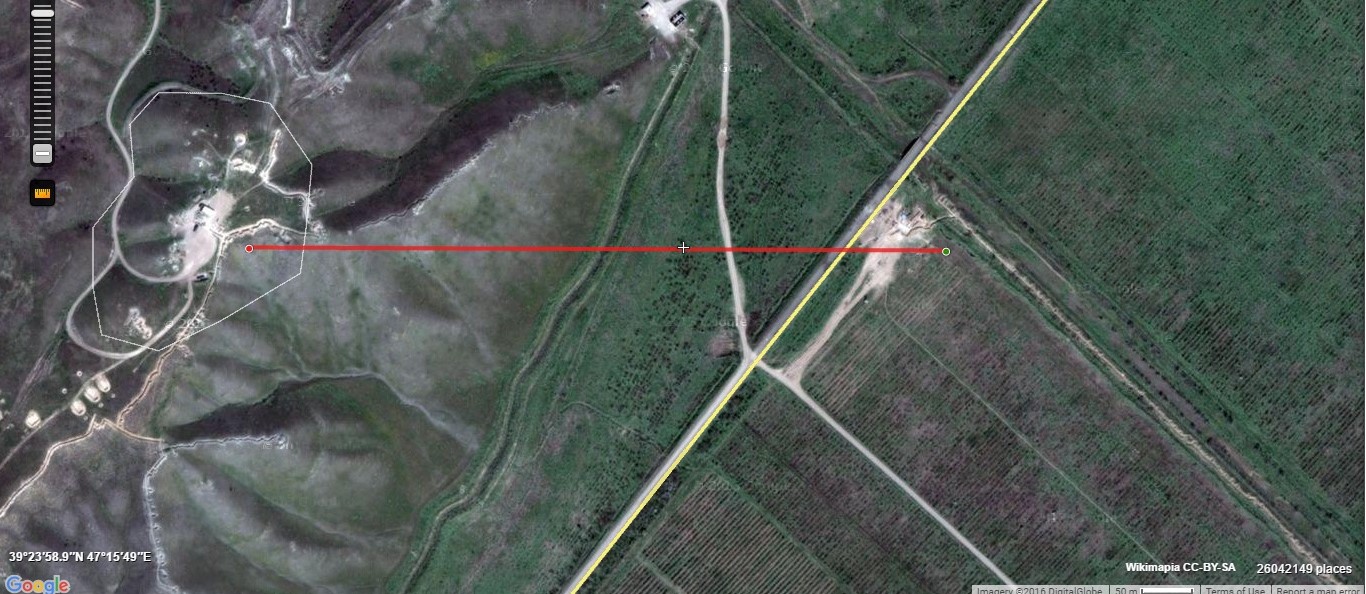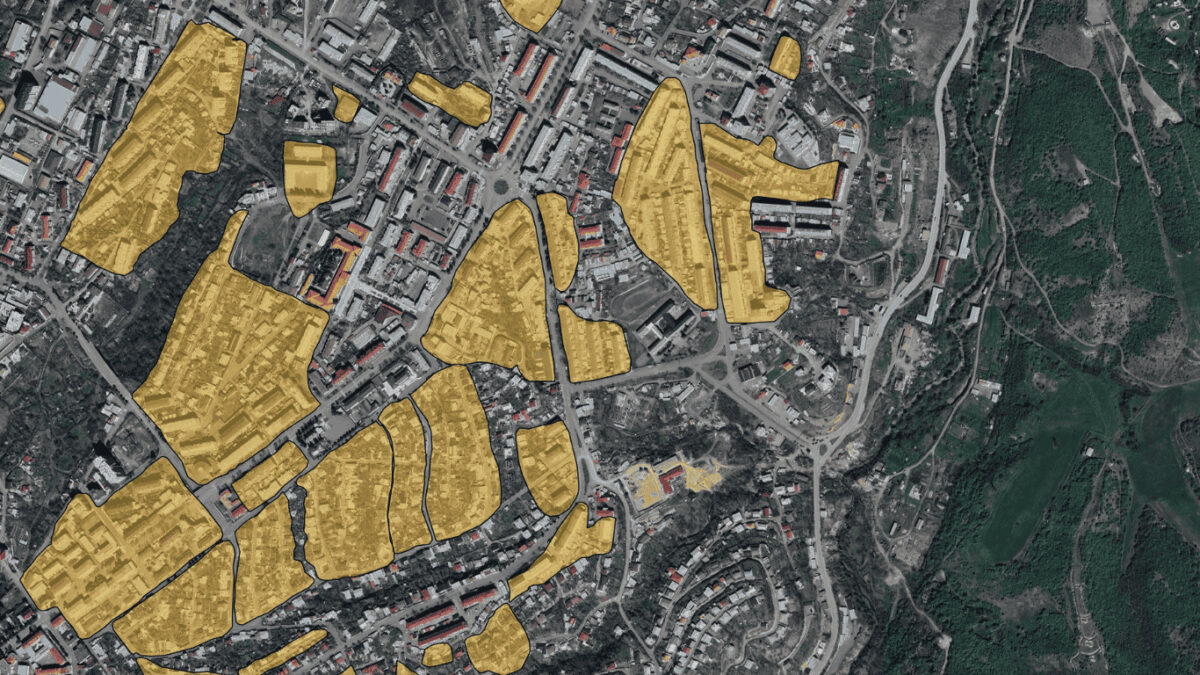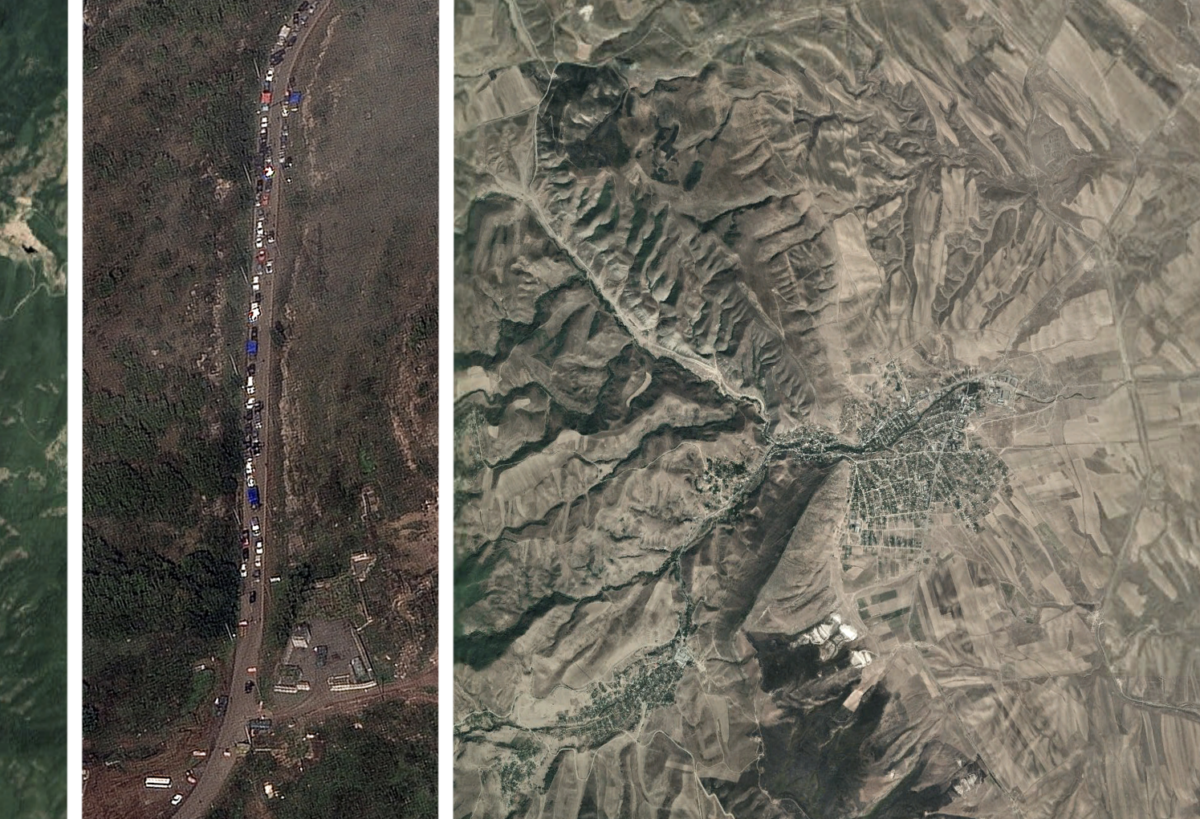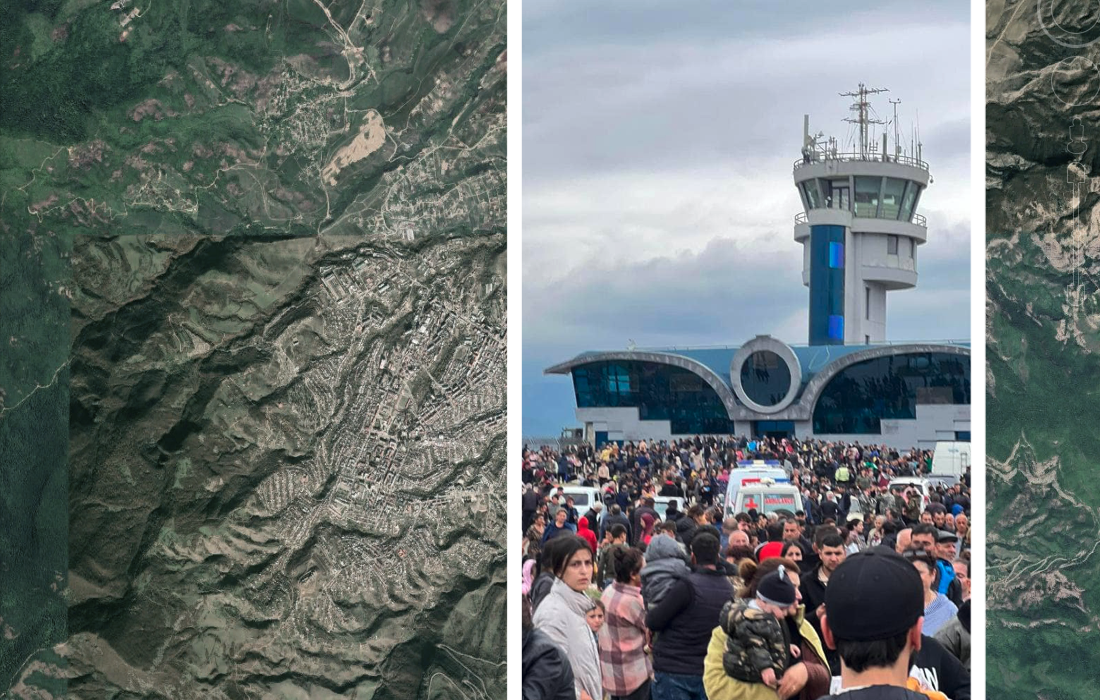Azerbaijan's Incremental Increase On The Nagorno Karabagh Frontline
The Red line illustrates the distance between the demarcation line and the newly seized post of Lele Tepe, a distance of approximately 1 km.
On April 2nd, reports began to flood in from the Northern villages of Karabagh regarding a major Azerbaijani offensive on their territory. By April 3rd, Azerbaijan’s President Aliyev openly admitted that he had felt compelled to act in response to the lack of progress in peace talks facilitated by the Minsk Group, with the international media quoting him as saying: “If Armenian soldiers don’t want to die, they should leave Azerbaijani territory.”[i] Azerbaijan utilised blitzkrieg tactics to capture villages along the Nagorno Karabagh frontline. The fighting came to a halt on April 5th. The 4-day battle was the culmination of an increasing escalation of clashes over the past 22 years of the “no war – no peace” stalemate, following the 1988-1994 war that left over 30,000 dead.
The Armenians have inhabited the Karabagh plains since ancient times. Fighting began with the arrival of nomadic Turkic tribes on the plains of Karabagh in the 1750s. While the originating causes of the conflict remain obscure, intermittent warfare continued into the 20th century. Azerbaijani historians now argue that the land belongs to Azerbaijan, based on the claim that they are descendants of Christian Caucasian Albanians. There was an uneasy, centrally imposed peace during Soviet times. With the pending collapse of the USSR, in December 1991 the autonomous region of Nagorno Karabagh voted overwhelmingly for independence. By then the war was well and truly underway, ending with a ceasefire in 1994. Since then, occasional flare-ups have undermined the peaceful resolution of the conflict.[ii]
While the 1994 ceasefire agreement effectively brought an end to full-scale warfare, it did not produce an entirely satisfactory outcome for either side. On the one hand, the victory of the people of Nagorno Karabagh did not translate into recognition as an independent state, and the threat of future war loomed over its head. On the other hand, Azerbaijan effectively lost control of several districts outside the autonomous region of Nagorno Karabagh, and increasingly used escalation of clashes to pressure its negotiation partner, Armenia, to agree to a compromise favorable to Azerbaijan. Due to the Minsk group failure of reaching a solution, Azerbaijan has openly admitted to the possibility of using force as a way of achieving its ends.[iii]
Armenian intelligence and imagery analysts have noted a shift in Azerbaijani strategy since 2014. Baku’s current strategy is now twofold. Firstly, it involves escalating tensions along the frontline at a snail’s pace to catch Armenia off guard, as shown by the gradual increase in heavy military hardware between 2014 and 2016 and the intensification of cross-border clashes. Secondly, as we saw last week, it involves applying full force on the day of attack, using blitzkrieg tactics to take opposing posts and to reclaim territory. Richard Giragossian, founding director of the Yerevan-based Regional Studies Center, notes: “Unlike each previous escalation, the Azerbaijani offensive campaign was based on a new strategy to seize, secure and sustain control of territory.”[iv]
On April 2nd, Armenia was caught off guard. While “tit for tat” escalations and the taking and retaking of military posts along the demarcation had been a constant feature of the 22 year ceasefire, with Special Forces periodically used to capture new trenches, the April 2nd offensive was on a significantly greater scale. Furthermore, the large scale indiscriminate bombing of civilian populations in villages on the frontline changed the character of the conflict. Smerch missiles and TOS A1 rocket launchers were also used for the first time. Armenia retaliated using howitzers to contain the oncoming attack. On the day of the surprise attack on April 2nd, the entire length of the Karabagh frontline was engulfed in fighting, with Karabagh forces taking the brunt of a concentrated effort by Azerbaijan in Talish and Madaghis in the North Eastern sector of Nagorno Karabagh.
With a strongly fortified frontline on the Karabagh side and many uninhabited villages across the entire length of the line of contact, questions have been raised as to why Azerbaijan subjected 3 inhabited villages to indiscriminate bombing. This may have been a tactic to kill the will of the Karabagh people, though a simpler explanation may be that it was intended to cause panic in the civilian population and divert attention while the Azerbaijani army proceeded to take important posts towards the Southern end of the frontline, while intensifying bombardment throughout the entire length of demarcation line.
At the same time, despite the potential firepower both countries have at their disposal, the war has been contained to the battle arena near the frontier villages. Both countries are bound by doctrines to ensure that the war does not draw in their reserves or, more importantly, major regional and global powers. For this reason, Armenia did not strike any key infrastructure behind the Azerbaijani frontline – a last resort in Armenia’s defense posture. Azerbaijan similarly limited its bombing to the frontier villages, and reports confirm that Stepanakert was not hit. However, the President of Azerbaijan made a clear announcement that Stepanakert would be targeted if Karabagh forces did not withdraw from the disputed territories. In response, President Serzh Sargsyan threatened Azerbaijan with retaliatory strikes. He also threatened to recognise Karabagh’s independence, a move that could have potentially escalated the conflict.
Azerbaijan successfully entered the outskirts of the village of Talish on the first day of fighting, with Karabagh’s conscript soldiers holding the front against Azerbaijan’s superior Special Forces. It is not known exactly when Karabagh began utilising its own Special Forces to conduct sweep-up operations in territory now controlled by Azerbaijan. Azerbaijan’s low-level tank incursion into the region tested Armenian anti-tank skills. Bellingcat has information that anti-tank battalions were utilised by Karabagh, as a number of Karabagh’s fatalities have been linked to various Special Forces for the battle of the heights overlooking Talish from the North and North East. Azerbaijani pro-Government news outlet Haqqin.az was quick to boast about the gains of their armed forces, particularly with regard to Talish.[v] Armenian news outlets also confirmed that there was a battle for the two villages.[vi] Nevertheless, the Azerbaijani military offensive was quickly slowed down. Karabagh’s forces began taking control of the battlefield and, by April 3rd, the area around Talish had come back under their full control. However, they were still far from their goal of regaining all the lost posts, and the fighting continued in this battlefield until April 4th.
The withdrawal of Karabagh forces to the second line was a deliberate strategy aimed at opening up a clear firing ground for high precision artillery strikes into Karabagh trenches now occupied by Azerbaijani Special Forces. Forfeiting parts of the first line allowed them to secure the second lines and to ensure effective rebuff of Azerbaijani attacks and oncoming troop movement. Subsequently, trenches in Karabagh now occupied by Azerbaijan came under heavy fire from the Armenian side. So, while Karabagh’s armed forces lost up to 8 posts within the first two days of fighting,[vii], Azerbaijani Special Forces came under heavy bombardment in the newly seized trenches and were soon under siege as they were surrounded by Karabagh armed forces. Karabagh used carefully planned flanking tactics to ensure heavy losses against a more powerful opposition. This clearly explains the huge material and personnel losses on the Azerbaijani side. It is yet to be understood why Azerbaijan gave up so much in financial and human losses for incremental advances on the frontline.
On the night of April 3rd, President Aliyev announced a unilateral ceasefire. This was a shrewd political-military tactic aimed at winning the global information war and potentially confusing Karabagh’s military planners on the ground. Western news outlets and some world leaders were quick to blame Armenia for the continued fighting along the battlelines, yet in reality there was no actual ceasefire on the ground. On the contrary, Aliyev’s announcement was followed immediately by the intensification of Azerbaijani attacks on the Southern parts of Karabagh. This strategy was an attempt to divert Karabagh firepower holding the lines at Talish, Madaghis and Martakert. Analysts conclude that capture of territory was the first key political objective for Azerbaijan, and video footage of a staged news report of the Azeri victory in Talish indicates that the seizure of territories was important for internal consumption. A second, broader strategy could have been to break the line and take important posts towards the south of the frontline, as seen by the capture of Lele Tepe, a strategic point on a hill.[viii]
Two ongoing issues for Karabagh have been the fire-to-target cost ratio and the timely replenishing of overall stock reserves. With its limited budget, taking out helicopters or small RCS targets such as drones with sophisticated air defense equipment would be fairly costly for Karabagh in a limited war. Depleted stocks would also present an issue in the case of a renewed attack or all out-war within a short time frame. In the current war, Karabagh was left taking out one helicopter with an RPG and using man pads for their air defense, posing both a logistical and financial issue for Karabagh on the battlefield. While Azerbaijan did not test the full potential of Karabagh’s air defense forces, they were quick to stop the air war and resorted to the use of their new Kamikaze Drones from Israel,[ix] a difficult low-RCS target for Karabagh’s older air defense systems.
Azerbaijan was able to break the line and achieve vital military objectives. Despite eventually losing the heights of the village of Talish, they were still in control of 8 posts (as confirmed by the Armenian media[x]) and continued their fight to retain their newly seized ground with heavy bombardment along the frontline. By April 4th (day 3), villages on the Karabagh side were emptied of their inhabitants because of indiscriminate bombing, though the inhabitants of Martakert, a larger village at the bottom of the Northeast sector, remained steadfast. Karabagh forces were overwhelmed by the Azerbaijani offensive and were forced to ensure the safety of their civilian population. At the same time, they were engaged in heavy battles to retake lost posts and bring the frontier back to pre-war lines. By the end of April 4th, the Karabagh forces had pushed back the Azeri offensive and were in control of most of the posts lost during the first 2 days of fighting. The tactic of retreat, bombardment and flanking employed by the Karabagh forces ensured that the conscript Karabagh army was able to hold off the major initial thrust from Azerbaijani Special Forces, with Karabagh Special Forces following through to begin sweep up operations and retake seized trenches and villages.
While the bombing was contained to the frontline, the war was not limited to military conflict. Azerbaijan launched a major cyber, information and communication war in an attempt to sabotage Karabagh’s relief efforts and dampen morale. Azerbaijani hackers infiltrated news websites and social media in Karabagh and Armenian. Counter hackers retaliated by taking down Azerbaijan government sites. In addition, reports suggest that Karabagh ceased all war-related communications via civilian internet and phone lines. Nevertheless, a busload of volunteer fighters from Armenia was hit with a direct strike by a Kamikaze drone, and Bellingcat suggests that this was made possible by Azerbaijani interception of Karabagh’s communication lines.
Another issue for Karabagh has been the overwhelming number of volunteers from Armenia and the Armenian diaspora heading to Stepanakert join the war effort, creating a potential logistical nightmare for the Karabagh forces and for the state. As a result, volunteer recruitment was quickly limited to highly trained individuals and groups.
By day 4, Azerbaijan had lost all but two posts from their initial thrust. Azerbaijan’s military offensive and strong tactical planning were offset by a sophisticated defensive response by Karabagh forces. April 4th was the last day of heavy fighting, with Karabagh forces managing to disengage artillery and grad strikes and concentrating their efforts on retaking the two remaining posts. Azerbaijan responded by concentrating on their main objective, namely that of holding on to newly seized ground, and as the battles diminished along the frontline the battle for Lele Tepe and other unidentified lost posts intensified. By this time, major powers had initiated diplomatic means to make sure that the battle did not turn into an all-out war. Armenian posts and trenches lost in the fighting are yet to be identified, though information tells us that one post was lost in the Northeast sector near the battlefront of Talish.[xi] The trench shown in the staged Azerbaijani victory footage, claimed to be at Talish, could in fact have been filmed at one of the nearby trenches or at the NorthEast heights of Talish were serious fighting raged. Another captured post down south closer to Fizuli, called Lele Tepe, was confirmed by Azerbaijani news agency Day.az.[xii] Video footage also confirms Azerbaijani soldiers digging in at Lele Tepe,[xiii] and trenches identified by Google Images[xiv] can be matched with available video footage. The Karabagh government has admitted to the loss of two “unimportant” posts, though Bellingcat has determined that an unknown number of other posts are still under Azerbaijani control. Bellingcat’s analysis also deduces that the Southern post of Lele Tepe[xv] is a vital strategic point for Karabagh, which means that gaining this post has been a strategic victory for Azerbaijan, providing its forces with open ground of one kilometre in length from which to fire into Karabagh in future battles. This leads analysts to conclude that the heavy fighting in the north could have been an effort to divert Armenian efforts while Azerbaijan took posts on the lower points of the contact line.
The exact length of the seized trench system is unknown, though reports suggest that approximately 1km is under Azerbaijani control.
Bellingcat can also conclude from contacts on the Azerbaijani side that the initial thrust was not as effective as anticipated. The objective had been to take villages along the frontline, as seen by news reports of victory by Azerbaijan. This was a shrewd tactic of multipronged continuous diversion attacks in the north and in the south to ensure that Karabagh’s line of defense was broken at any cost. However, from the moment that they were met with fierce resistance, Azerbaijan changed tactics, hence Aliyev’s ceasefire announcement. Aliyev was quick to announce a victory for the Azerbaijani side, with a number of videos surfacing on YouTube. For instance, a video published on April 3rd shows the heights of Talish from the Azerbaijani side, obviously taken on the day of fierce fighting when Karabagh forces were fighting for the outskirts of the village of Talish.[xvi] However, a staged victory footage that surfaced on YouTube on April 8th showed only a small glimpse of a mountaintop, with a reporter standing next to a signpost identifying the village of Talish[xvii]. We have yet to see recent confirmed footage of Talish from Azerbaijani news sources. Other heavy reporting from the hilltop of Lele Tepe also confirms Azerbaijan’s intense media campaign to show its forces as being victorious.
While the battle plans of both countries were sophisticated and well executed, the loss of personnel was greater than anticipated, especially on the Azerbaijani side. The ratio of Azerbaijani human and material loss versus territorial gain was high, especially in the light Azerbaijan only partially achieving its goal of taking strategic posts. The defender usually suffers one-third of the casualties of the attacker, and we know that Karabagh’s superior defense tactics ensured heavy losses among Azerbaijan’s Special Forces. Based on available statistics, the Karabagh side has approximately 50 dead, over 100 injured and 18 missing in action, though this figure increases by the day with new figures reaching beyond 70. This death toll illustrates the heavy battles that raged for the retake of lost posts. It is likely that releasing the number of dead incrementally is a tactic by Karabagh to downplay the death toll. From all of this, we can deduce that the number of losses on the Azerbaijani side would be higher. Using estimates from various sources, Bellingcat concludes that there were at least 400 Azerbaijani fatalities, which means that the fatality rates publicly cited by Azerbaijan are also underestimated. Other estimates are in the thousands, though a conservative estimate by Bellingcat suggests a range of between 400 and 500.
In initiating these latest clashes, Azerbaijan has pushed Armenia away from the negotiating table, undermined the Madrid principles and forfeited any possibility of peaceful resolution. Those in Armenia who had previously advocated a return of some of the disputed territories to Azerbaijan are now advising their government that this is no longer possible, in the light of Azerbaijan resorting to war. This is an unfortunate turn of events and does not bode well for the future. Prior to April 2nd, Azerbaijan faced a flexible negotiating partner who was willing to consider a compromise agreement. Azerbaijan’s impatience and ‘all or nothing’ approach, culminating in the April 2nd attacks, have resulted in the Armenian side digging its heels and Azerbaijan is now left with little to show for except the loss of a potential compromise agreement.
The white circle surrounding the trench illustrates the trench system upon a hill seized by Azerbaijan. The red line represents the distance between the first and second lines of trenches of the Karabagh forces, a distance of approximately 500 metres.
[i] https://www.youtube.com/watch?v=TRWLP8t2DSA (In English, translated by Azerbaijani Radio Free Europe).
[ii]http://www.aljazeera.com/indepth/opinion/2015/09/war-looms-south-caucasus-150914105543346.html and
[iii] https://www.stratfor.com/analysis/russia-trying-maintain-balance-caucasus.
[iv] http://www.regional-studies.org/news/events/briefings/541-040416.
[v] http://haqqin.az/news/67706.
[vi] http://www.tert.am/en/news/2016/04/06/Talish/1985131 and http://www.tert.am/en/news/2016/04/06/Talish/1985140.
[vii] http://www.yerkir.am/news/view/104389.html.
[viii] http://news.day.az/azerinews/767758.html and
https://www.youtube.com/watch?v=IcepglIxf_s&nohtml5=False.
[ix] http://www.timesofisrael.com/azerbaijan-said-using-israeli-drones-against-armenians/ and
[x] http://www.yerkir.am/news/view/104389.html.
[xi] https://www.youtube.com/watch?v=HmxVL2dk87s&nohtml5=False.
[xii] http://haqqin.az/news/67706.
[xiii] https://www.youtube.com/watch?v=IcepglIxf_s
[xiv] 39°24’29.14″N 47°16’6.28″E.
[xv] 39°24’29.14″N 47°16’6.28″E.
[xvi] https://www.youtube.com/watch?v=CJ9m0o5BAcw&nohtml5=False.
[xvii] https://www.youtube.com/watch?v=HmxVL2dk87s
By Masis Ingilizian
The author would like to acknowledge the contribution of Dr Armen Gakavian in producing this article. He is also grateful to Ani Mejlumyan for her assistance with sources and for identifying key informants in the battlefield and in Baku.
